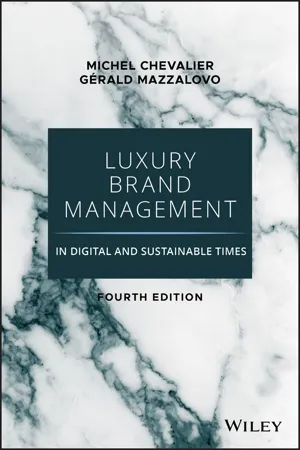
Luxury Brand Management in Digital and Sustainable Times
- English
- ePUB (mobile friendly)
- Available on iOS & Android
Luxury Brand Management in Digital and Sustainable Times
About this book
Learn about the luxury brand industry from the inside out with this masterful and insightful resource
The newly revised Fourth Edition of Luxury Brand Management in Digital and Sustainable Times delivers a timely re-examination of what constitutes the contemporary luxury brand landscape and the current trends that shape the sector. Distinguished experts and authors Michel Chevalier and Gerald Mazzalovo provide readers with a comprehensive treatment of the macro- and micro-economic aspects of management, communication, distribution, logistics, and creation in the luxury industry.
Readers will learn about the growing importance of authenticity and sustainability in the management of fashion, perfume, cosmetics, spirits, hotels and hospitality, jewelry, and other luxury brands, as well as the strategic issues facing the companies featured in the book. The new edition offers:
- A new chapter on the "Luxury of Tomorrow, " with a particular focus on authenticity and durable development
- A completely revised chapter on "Communication in Digital Times, " which takes into account the digital dimension of brand identity and its implications on customer engagement activities and where the concept of Customer Journey is introduced as a key marketing tool
- A rewritten chapter on "Luxury Clients" that considers the geographical changes in luxury consumption
- Considerations on the emerging notion of "New Luxury"
- Major updates to the data and industry figures contained within the book and a new section dedicated to the hospitality industry
- New semiotic analytical tools developed from the authors' contemporary brand management experiences
Perfect for MA and MBA students, Luxury Brand Management also belongs on the bookshelves of marketing, branding, and advertising professionals who hope to increase their understanding of the major trends and drivers of success in this sector.
Frequently asked questions
- Essential is ideal for learners and professionals who enjoy exploring a wide range of subjects. Access the Essential Library with 800,000+ trusted titles and best-sellers across business, personal growth, and the humanities. Includes unlimited reading time and Standard Read Aloud voice.
- Complete: Perfect for advanced learners and researchers needing full, unrestricted access. Unlock 1.4M+ books across hundreds of subjects, including academic and specialized titles. The Complete Plan also includes advanced features like Premium Read Aloud and Research Assistant.
Please note we cannot support devices running on iOS 13 and Android 7 or earlier. Learn more about using the app.
Information
Chapter 1
The Concept of Luxury
A Problematic Definition
A Fluctuating Notion
The Paradox of Contemporary Luxury
Chronicle of a Semantic Evolution
- Brands have realized that this (sometimes only apparent) positioning adds to their competitiveness.
- On the other hand, a majority of consumers have developed a positive attitude toward the products, services, or experiences connoted by this feature.
Modern Dispersion
Etymology and Transformations
- 1607: “way of life characterized by large expenditures to make shows of elegance and refinement”
- 1661: “character of which is expensive, refined,” luxury clothing
- 1797: “expensive and superfluous object, pleasure”
- 1801: “excessive quantity,” a luxury of vegetation
- 1802: “which is superfluous, unnecessary”
Table of contents
- Cover
- Table of Contents
- Title Page
- Copyright
- Introduction
- Chapter 1: The Concept of Luxury
- Chapter 2: Specificities of the Luxury Industry
- Chapter 3A: Major Luxury Sectors
- Chapter 3B: Major Luxury Sectors
- Chapter 4: The Power of the Luxury Brand
- Chapter 5: The Luxury Client
- Chapter 6: Brand Identity: Concepts and Analytical Semiotic Tools
- Chapter 7: Additional Brand Analytical Tools
- Chapter 8: Creation and Merchandising
- Chapter 9: Communication in Digital Times
- Chapter 10: Managing a Global Brand
- Chapter 11: Retail Management
- Chapter 12: Sustainability and Authenticity
- Appendix A: Applying Brand Identity Analytical Tools
- Appendix B: Glossary of Digital-Related Terms
- Index
- End User License Agreement